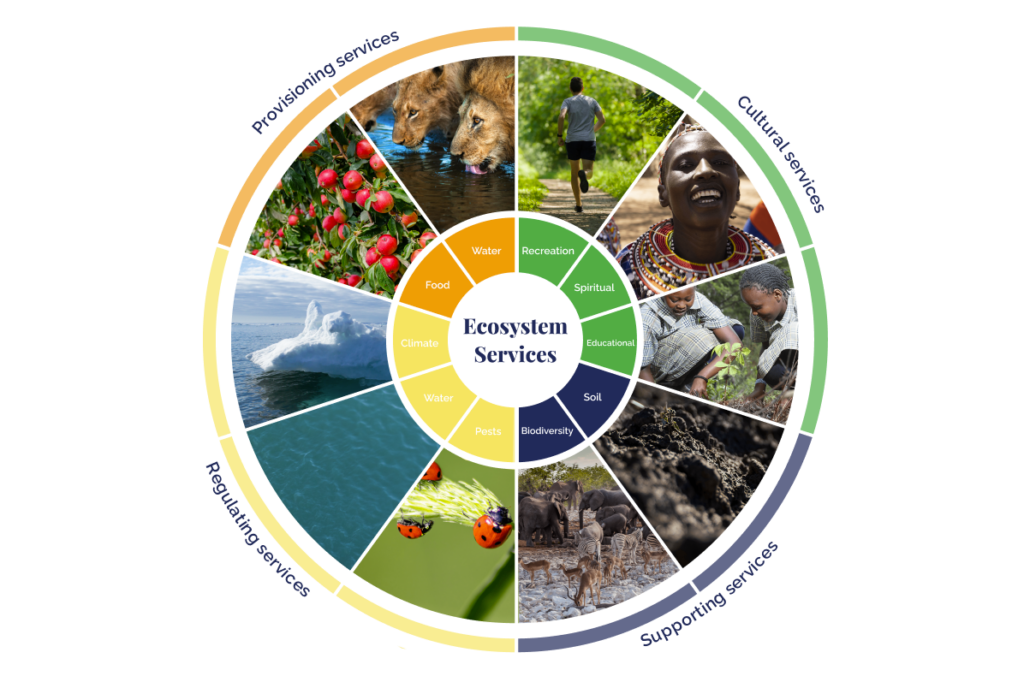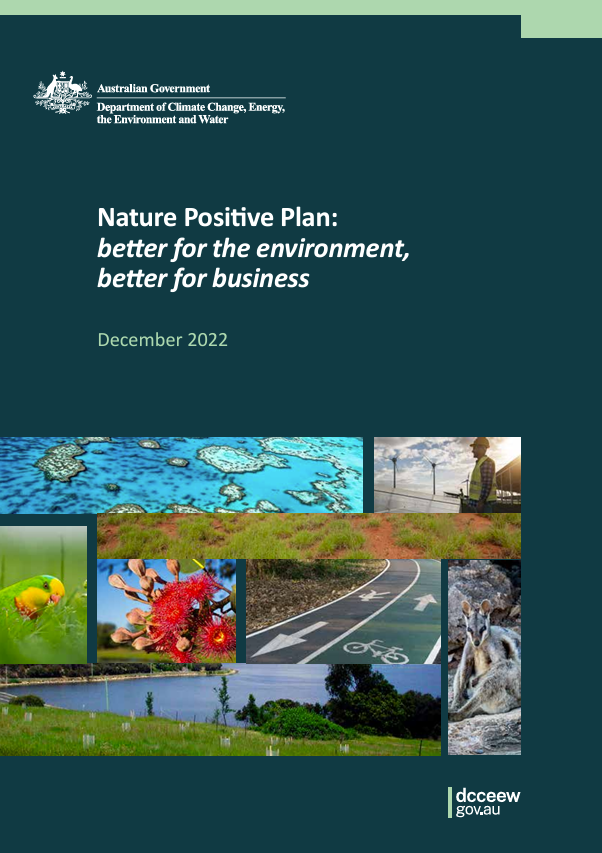Imagine a world where Nature is actively restored and thriving. This vision, known as Nature Positive, and it stands as a stark contradiction to the current reality of increasing biodiversity loss. With over one million known species at risk of extinction, the needs to alleviate the pressure on our ecosystems is more evident than ever (IPBES, 2019). Long-term human activities, from habitat destruction to pollution, have significantly contributed to the degradation of our natural world, creating an urgent call to action (Chu & Karr, 2017).
This insight discusses the concept of Nature Positive, its benefits, and stakeholders’ roles in securing a future where humanity and Nature flourish in harmony. The transitions to a Nature Positive world depend on how humanity navigates, plans and is committed to this outcome.
The Concept and Its Origin
Nature Positive aims to shift our (human) relationship with the natural world from depletion to active restoration and enhancement. In essence, it strives to ensure that by 2030 and beyond, the world has more Nature than we did in 2020 (Figure 1). It also seeks to restore the plant biodiversity by 2050. Achieving this outcome requires a paradigm shift across all sectors and societies to prevent further biodiversity loss while actively increasing the abundance and quality of the Earth’s ecosystems.

The term “Nature Positive” first emerged in the 1970s within the US policies related to wetland and pollution, although it was referred to as “no net loss” and “net positive impact” (Ermgassen, et al., 2022). The change from “no net loss/net positive impact” to “Nature Positive” happened in recent years. It gained significant traction following the COP15 biodiversity conference in 2021 when it was adopted as a global societal goal.
At its core, Nature Positive pursues two primary objectives:
- Halting and reversing biodiversity loss: This entails addressing the factors driving habitat destruction, overexploitation, pollution, and climate change, ultimately halting the current decline in species populations and ecosystem health and
- Enhancing Nature: Beyond simply stopping the bleeding, Nature Positive aims to repair and improve ecosystems actively. Which includes activities like habitat restoration, reforestation, species reintroductions, and improved management practices that promote biodiversity and ecosystem resilience.
Measuring progress towards Nature Positive is a complex but crucial endeavour. Several metrics may be employed, with the most common being (NPI, 2022):
- Changes in species abundance and diversity: Monitoring population trends for various species, particularly indicators and keystone species, provides insights into the overall health of ecosystems.
- Habitat extent and quality: Tracking changes in the area and quality of various habitats, like forests, grasslands, and wetlands, reveals the progress made in restoration and conservation efforts and
- Ecosystem services: Measuring the flow of benefits that Nature provides to human societies, such as clean water, food security, climate regulation, and others (Figure 2), helps assess the impact of Nature Positive actions.

It should be noted that challenges exist in standardising and ensuring robust measurement across different ecosystems, but the above metrics do provide valuable indicators of progress toward Nature Positive.
The Relationship Between Nature Positive and the Society
The benefits brought by Nature Positive extend far beyond the boundaries of ecosystems; they can influence and enrich human societies. Nature Positive can improve our lives through:
- Food security and economy: Nature is the engine that keeps our food chains active, feeding millions around the world. But our food security is at risk when ecosystems get beat up, especially by land degradation. Nature Positive aims to heal these ecosystems by fixing farmland and promoting sustainable farming, bringing more diverse food sources, better soil management, and bigger harvests. It can also create jobs, strengthen rural communities, and help manage water and pollution, positively impacting the economy and promoting a healthier planet (UN, 2022).
- Resilience and disaster risk reduction: Healthy ecosystems act as natural buffers against extreme weather events such as floods, droughts, and storms. By restoring wetlands, forests, and coastal ecosystems, Nature Positive builds societal resilience, protecting infrastructure and livelihoods from the increasing intensity and frequency of natural disasters. This translates to reduced economic losses and disruptions, safeguarding communities and vital resources (IUCN, 2017).
- Educational and scientific opportunities: Thriving ecosystems are classrooms for scientific discovery, including those in the medicine and technology field, offering invaluable opportunities for research and environmental education. Nature Positive efforts create platforms for citizen science initiatives, engaging individuals in conservation, science and stewardship activities. This fosters environmental awareness, empowers communities, and fuels the next generation of scientists and conservationists (DGB Group, 2023).
- Enhanced well-being and health: Nature Positive initiatives that restore forests and parks can be powerful tools for promoting public health and well-being. Nature provides a sanctuary for both mental and physical well-being. Studies have shown that spending time in natural environments reduces stress, lowers blood pressure, and improves mood. For example, increased access to green spaces in cities fosters healthier communities and reduces healthcare costs (Jimenez, et al., 2021).
- Cultural and spiritual connections: Nature holds deep cultural and spiritual significance for many societies, weaving its way into traditions, art, and storytelling. Protecting and enhancing biodiversity preserves these vital connections, strengthens cultural identities, and fosters a sense of place within communities. This intangible value of Nature Positive contributes to social cohesion and enriches the human experience (Verschuuren, et al., 2021).
The benefits of Nature Positive extend far beyond environmental gains by fostering healthier societies, resilient communities, and sustainable economies. Nature Positive may represent a transformative pathway towards a brighter future for people and the planet.
The Role of Stakeholders to Pursue Nature Positive
Nature Positive is a collective journey where everyone has a crucial role. Let’s briefly explore the responsibilities and potential benefits for different stakeholders on this path:
- Society:
- Individuals: Every action counts! Opting for sustainable choices like responsible consumption, minimising waste, and supporting conservation initiatives fuels the momentum for Nature Positive;
- Communities: Working together in community gardens, advocating for green spaces, and participating in citizen science projects empowers local action and drives positive change;
- Indigenous communities: As stewards of traditional ecological knowledge and guardians of biodiversity, their voices and leadership are vital in shaping nature-based solutions and ensuring equitable outcomes.
- Companies:
- Businesses: Integrating sustainability into core operations, adopting responsible sourcing practices, and investing in nature-based solutions like habitat restoration can enhance brand reputation, attract talent, and drive long-term value;
- Financial institutions: Providing funding for sustainable projects, green bonds, and responsible investment strategies can unlock financial resources for Nature Positive initiatives;
- Innovators: Developing and deploying green technologies like renewable energy, precision agriculture, and eco-friendly materials can accelerate progress towards a nature-positive future.
- Regulators:
- Governments: Setting policy frameworks, enacting environmental regulations, and providing incentives for sustainable practices can guide and accelerate the transition towards Nature Positive;
- Non-governmental organisations (NGOs): Advocating for policy changes, raising public awareness, and implementing conservation projects are crucial in holding stakeholders accountable and driving tangible results.
As we journey towards a Nature Positive world, envision each of us playing a vital role, much like a team working together. Whether making mindful choices as an individual, collaborating with your neighbours on local projects, or even influencing larger companies, it’s always important to remember every contribution matters. Think of it as a linked chain, where each of us is responsible for keeping it connected. Together, individuals, communities, companies, and governments can actively contribute to a Nature Positive world. It’s about our everyday choices collectively leading to a greater goal. So, let’s continue playing our parts, big or small, in shaping a future where Nature and people thrive together.
What Steps Can We All Take?
We have just started a new year, which provides an opportunity to decide whether to commit to Nature Positive or not. It is up to us whether to:
- Embracing Nature Positive:
- For the planet: landscapes full of biodiversity, resilient ecosystems buffering against climate extremes, and clean air and water-supplying communities. Nature Positive promises a restored and flourishing natural world, ensuring the continued provision of vital ecosystem services that underpin our existence.
- For the society: Healthy ecosystems translate to healthy people. Cleaner air and water, greater access to green spaces, and reduced exposure to pollutants may be expected. This leads to improved physical and mental well-being, stronger communities, and a boost in societal resilience against natural disasters and pandemics.
- For the economy: Nature Positive unlocks new economic opportunities. Ecotourism, sustainable agriculture, and green technologies driving innovation and job creation are some opportunities.
- Ignoring the Call:
- A stark path: Continued biodiversity loss, ecosystem degradation, and climate change impacts intensify, leading to food insecurity, water scarcity, and increased vulnerability to natural disasters. The consequences ripple through societies, straining economies, displacing communities, and even jeopardising our very future;
- Health under threat: Expect increased air and water pollution, heat waves, and the spread of zoonotic diseases. This translates to rising healthcare costs, decreased productivity, and a decline in overall public health and well-being.
- A bleak economic outlook: Unsustainable practices lead to resource depletion, declining ecosystem services, and instability. It may lead to unreliable supply chains, reduced agricultural yields, and the loss of valuable natural resources.
Australia has taken promising steps towards Nature Positive with, for example, the Nature Positive Plan launched in December 2022. This plan outlines the Federal government’s strategy for improving Australia’s environmental laws to safeguard, rehabilitate, and preserve the distinct environment. The plan includes reforming the Commonwealth environmental laws, establishing a nature repair market and creating an independent Federal environmental agency.
However, the challenges remain as we are yet to see these actions in practice and to start to reap the benefits. Embracing Nature Positive can unlock a future where Australia becomes a global leader in sustainable practices, thriving ecotourism, and resource-efficient industries.

If you want to embrace Nature Positive, Integrate Sustainability is available to guide you or your business on your Nature Positive Journey; call us at 08 9468 0338 or email us at enquiries@integratesustainability.com.au.
By working together, we can contribute to a global movement that fosters nature-positive actions.
References
Chu, E., & Karr, J. (2017). Environmental Impact: Concept, Consequences, Measurement. Reference Module in Life Sciences. doi:10.1016/B978-0-12-809633-8.02380-3
DGB Group. (2023, May 20). 10 Vital ecosystem services: sustaining life on Earth. Retrieved 01 15, 2024, from DGB Group: https://www.green.earth/blog/10-vital-ecosystem-services-sustaining-life-on-earth
Ermgassen, S. O., Howard, M., Bennun, L., Addison, P. F., Bull, J. W., Loveridge, R., . . . Starkey, M. (2022). Are corporate biodiversity commitments consistent with delivering ‘nature-positive’ outcomes? A review of ‘nature-positive’ definitions, company progress and challenges. Journal of Cleaner Production, 379(2). doi:https://doi.org/10.1016/j.jclepro.2022.134798
IPBES. (2019). Summary for policymakers of the global assessment report on biodiversity and ecosystem services of the Intergovernmental Science-Policy Platform on Biodiversity and Ecosystem Services. 56. Bonn, Germany: IPBES secretariat. doi:https://doi.org/10.5281/zenodo.3553579
IUCN. (2017). Nature-based Solutions to Disasters, Prepared by International Union for Conservation of Nature. Gland: International Union for Conservation of Nature.
Jimenez, M. P., DeVille, N. V., Elliott, E. G., Schiff, J. E., Wilt, G. E., Hart, J. E., & James, P. (2021). Associations between Nature Exposure and Health: A Review of the Evidence. International journal of environmental research and public health, 18(9). doi:https://doi.org/10.3390/ijerph18094790
NPI. (2022). The MeasurableNature PositiveGoal for the CBD Mission, Prepared by Nature Positive Initiative. Nature Positive Org.
NPI. (2023). A Global Goal for Nature – Nature Positive by 2030, Prepared by Nature Positive Initiative. Retrieved 12 22, 2023, from Nature Positive Organisation: https://www.naturepositive.org/
UN. (2022). Boosting Nature- Positive Food Production, Prepared by United Nations – Action Guide 1. Unied Nations Convention to Combat Desertification.
Verschuuren, B., Mallarach, J.-M., Bernbaum, E., Spoon, J., Brown, S., Borde, R., . . . Lee, E. (2021). Cultural and spiritual significance of Nature. Guidance for protected and conserved area governance and management. Best Practice Protected Area Guidelines Series No. 32, 88. Gland, Switzerland: International Union for Conservation of Nature.

